Россия
BISAC NAT010000 Ecology
BISAC NAT045050 Ecosystems & Habitats / Coastal Regions & Shorelines
BISAC NAT025000 Ecosystems & Habitats / Oceans & Seas
BISAC NAT045030 Ecosystems & Habitats / Polar Regions
BISAC SCI081000 Earth Sciences / Hydrology
BISAC SCI092000 Global Warming & Climate Change
BISAC SCI020000 Life Sciences / Ecology
BISAC SCI039000 Life Sciences / Marine Biology
BISAC SOC053000 Regional Studies
BISAC TEC060000 Marine & Naval
Multiple scale climate variability in Asia of temperate and high latitudes, Pacific, Indian and South Oceans, their features and linkages are studied by using statistical analyses of monthly mean time series of Hadley, Reynolds SST, surface net heat flux (Q), atmospheric pressure (SLP), air temperature (SAT) from NCEP NCAR reanalyses (1948-2015). Three multidecadal climatic regimes were revealed for the whole area studied by using cluster analyses via Principal Components of differences between values of Q, SLP, SAT in tropical and extratropical regions of the Asian Pacific, Indian and Southern Oceans. The climate regime change in 70s of the 20th century in this area is confirmed by this method. It is also found that the climate regime is significantly changed at the end of the 20th century in both same area and World Ocean. The characteristic features of recent climate regime after 1996-1998 are SLP increase in the central extratropic area of Indian Ocean, North and South Pacific being prevailing in boreal winter. It is accompanying SLP increase and precipitation decrease in South Siberia and Mongolia prevailing in boreal summer. Inversed SLP and precipitation anomaly associated with increase of cyclone activity and extreme events in the land-ocean marginal zones including Southern Ocean, eastern Arctic, eastern Indian, western and eastern Pacific margins. It is known that low frequency PDO phase is also changed at the same time.
climatic, anomaly, regime, change, Pacific, Indian, Arctic, Southern, ocean, marginal seas, Asia, Mongolia, China, Siberia, Russian Far East, coastal zone, river basins, sea level pressure, surface, sea, air, temperature, heat fluxes, precipitable water content, precipitation, extreme events, flood, drop, level of lake, Lake Baikal, Lake Khanka.
- Introduction
The multidecadal oscillation of period 65-70 years was determined as a typical phenomenon in the global climate system [1]. Features of similar scale oscillations with period 50-60, 50-70 years were revealed in various meteorological and oceanographic characteristics in the North Pacific [2, 3, 4], Arctic [4, 5, 6, 7, 8] and Atlantic Oceans [8, 9]. Cause and possible mechanism [1 - 4, 5 - 7] of this oscillation suggested by various authors are quite different and not yet proven. Well expressed transitional periods between the positive and negative phases of the multidecadal or interdecadal oscillation are usually characterized by very rapid change in parameters of the ocean-atmosphere system [1]. The transition period named as climate regime shift in late 70s of the 20th century was clear shown in both North Pacific [10] and North Atlantic [11] in many studies.
The recent climate regime shift in late 90s - 2000 is also shown in the state of North Atlantic [11], North Pacific [12, 13, 14]. In the North Atlantic it is shown in terms of phase trajectory of Sea Level Pressure (SLP), Sea Surface Temperature (SST) differences between its values in the Azores High area and Icelandic Low region [11]. Similar recent shift in the state North Pacific from 1996 to 1999 [12] is determined in terms of phase trajectory of the first two principal components (PC) of SST anomalies in the North Pacific The PC2 rapidly rises from negative value -1 in 1996 to 0,2 in 1998 and 0.9 in 1999. During four years 1999 - 2012 PC2 was in a stable positive phase with unusually high values 1.4 - 1.5. It is also manifested that physical devises of the transitions of the winters 1988, 1989 and 1976, 1977 are different and related to impact of anomalies in Arctic and tropical regions correspondently [13]. In this case a phase of different scale oscillations decadal and multidecadal was changed.
The climate regime change in late 90s in the Asia, Indian, North and South Pacific Oceans is also determined in terms of phase trajectory of Sea Level Pressure (SLP) and surface net heat flux (Q) differences between its values in selected large-scale areas of the Asia of temperate latitudes, Pacific and Indian Oceans [15]. The recent changes in the SLP and ocean-atmosphere interaction are associated with the increase in the frequency of occurrence of extreme events, severe storms, floods in some areas and droughts in others observed in the world in the first 15 years of the 21 century including extremes in 2014, 2015. In Russia the extremely low total rivers discharge in the Lake Baikal Basin and extremely low the lake water level are observed in summer and fall 2015 despite of some adjustment of the lake level change using dams of hydropower plants reservoirs on the Angara River. At the same time, an inverse extreme anomaly is observed in the Lake Khanka situated in the south of Russian Far-East (Primorskii Krai). The flood of the Lake Khanka has reached catastrophic level in the fall of 2015 that has led to destruction of the shores of the lake, buildings and the entire coastal infrastructure, as well as flooding of agricultural grounds. The problem is that the Lake Khanka is a transboundary lake. The border between Russia and China, crossing the lake near the sand spit that divides the lake into Small Lake Khanka (China) and a Big Lake Khanka. The main goals of our study are to identify the various features of the recent climate regime change in SLP, Q, precipitation (Pr), Precipitable Water Content in the atmosphere (PWC, kg/m2) over the continent, ocean, and their marginal zone using observation data from various data sets and different statistical methods, including cluster analyses via PCA. Objectives of our work are also to define scenarios of significant anomalies and extreme events in precipitations in South of Siberia, Mongolia, Lake Baikal Basin, as well as in the subarctic coastal area of the Japan (East) Sea, South of Russian Far East and Khanka Lake Basin in the Primorskii Region.
II. Data and methods
We use observation data from different from various sources, particularly gridded monthly mean time series of Hadley Sea Surface Temperature (SST) from 1870 to 2015, Reynolds SST, Sea Level atmospheric Pressure (SLP), air temperature (SAT), surface net heat flux (Q), precipitation (Pr), Precipitable Water Content (PWC, kg/m2) in the atmosphere from NCEP NCAR meteorological reanalyses, particularly monthly mean gridded (2.5° x 2.5°) from 1948 to 2015, as well as monthly mean time series of precipitation, SAT at the meteorological stations and correspondent gridded time series (1° x 1°) over land from 1900 to 2015.
In our paper the positive value of the vector Q corresponds to the heat flux directed from an ocean surface to the ocean under-surface layer, while the negative one corresponds to the heat flux directed from an ocean surface to the atmosphere. The characteristic features of the climate regime change in late 90s of the 20th century are estimated using anomalies of monthly, seasonal and annual mean SLP, Q, Pr, PWC, SAT, SST in the Pacific, Indian and Southern Oceans, as well as SLP, Q, Pr, PWC, SAT in Asia of temperate latitudes. Various methods of the observation data processing are applied including correlation analyses, Principal Component Analyses (PCA) and cluster analysis via PCA.
III. RECENT CLIMATIC REGIME CHANGE
Based on the cluster analyses of the SLP, Q, SST anomalies via PCA, as well as correlation analyses between winter anomalies in Lake Baikal Basin, Okhotsk, Japan Seas [16] and anomalies of Q, SST in the Pacific and Indian Oceans the major large scale regions were selected to analyze time series of SLP, Q, Pr, PWC, SAT, SST averaged within the regions. The square and positions of the regions are shown in Tabl.1 and Fig.1.
Table 1. Regions of Q, SLP, TWC, Precipitation averaging and their position and square (S, km²).
|
Regions |
Lat.1 |
Lat.2 |
Lon.1E |
Lon.2E |
S (km²) |
|
1.Asia of Moderate Lat. (AML) |
40 |
60 |
70 |
130 |
9854109 |
|
2. Subarctic North Pacific (SNP) |
40 |
60 |
160 |
226 |
10437686 |
|
3. Hawaii High (HH) |
20 |
40 |
180 |
230 |
10653527 |
|
4. West Tropic Pacific (WTP) |
10 |
-15 |
155 |
190 |
10722938 |
|
5. NINO 3-4 |
5 |
- 5 |
190 |
240 |
6174312 |
|
6. South Indian (SI) |
-20 |
- 45 |
60 |
100 |
10345429 |
The climate regime change is estimated, at first, in terms of phase trajectory of certain characteristics in two selected regions. Fig. 2 shows climatic shift both in mid 70s and late 90s in phase trajectory of two net heat fluxes (Q, W/m2) time series of Q2 in Subarctic Pacific (in axes Y region 2 in Fig.1, Tabl.1) and Q6 in South Indian Ocean (in axes Y region 2 in Fig.1, Tabl.1) from 1948 to 2015 in boreal hydrological winter (JFM). It means that Q2 is in winter of the Northern Hemisphere, while, Q6 is in summer of the Southern Hemisphere. Vector of Q2 is directed from an ocean surface to the atmosphere and values of Q2 are negative in our paper, while the vector of Q6 is directed from an ocean surface to the ocean undersurface layer and values Q6 are positive. Two climate regime shifts, particularly after 1975 and after 1995 are clear seen in Fig. 1.
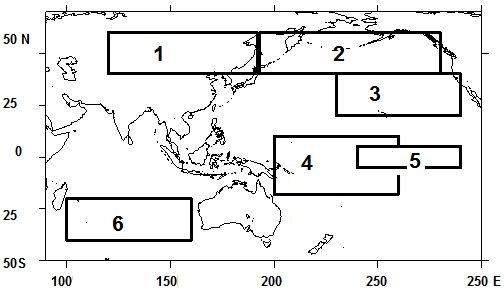
Fig.1. Arrangement of regions of Q, SLP, Pr, TWC averaging in the Asian Pacific Region and Indian Ocean : 1 – the zone of temperate latitudes of Asia; 2 – subarctic zone; 3 – Eastern subtropical zone; 4 – Western Equatorial zone; 5 – El Nino (NINO 3-4); 6 – South Indian Ocean
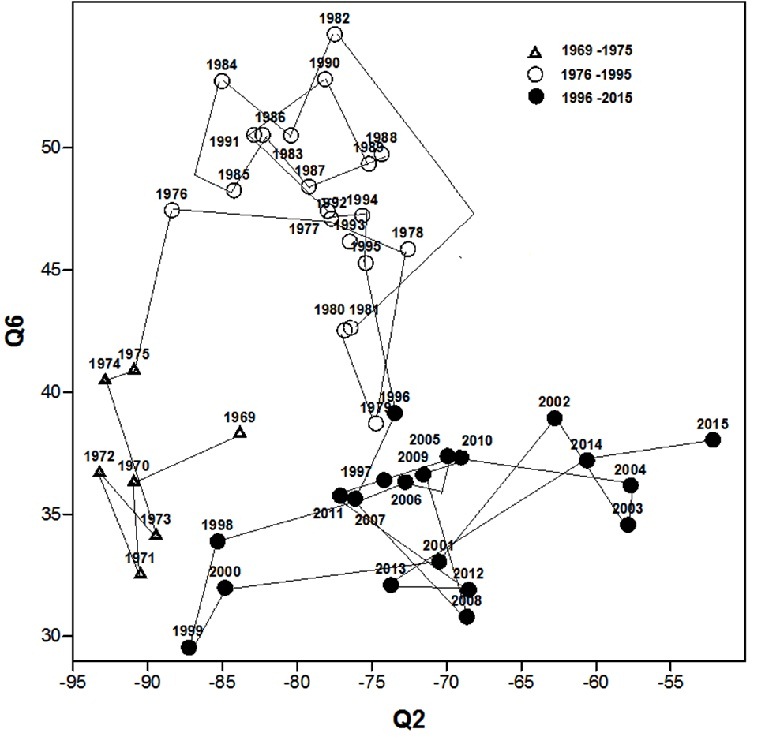
Fig. 2. Phase trajectory of the net heat fluxes (Q, W/m2) of 3-years running mean time series (1969 - 2015) averaged in Subarctic Pacific (Q2) and South Indian Ocean (Q6) in boreal winter (JFM). Regions 2 and 6 are shown in Fig. 1.
Similar two climate regime shifts in the phase trajectory of the net heat flux at the ocean surface in Subarctic Pacific and South Indian Ocean is also found in summer (JJA) time series of Q2 and Q6. The winter and summer time series of Q2 and Q6 are shown in Fig. 3, 4 correspondently.
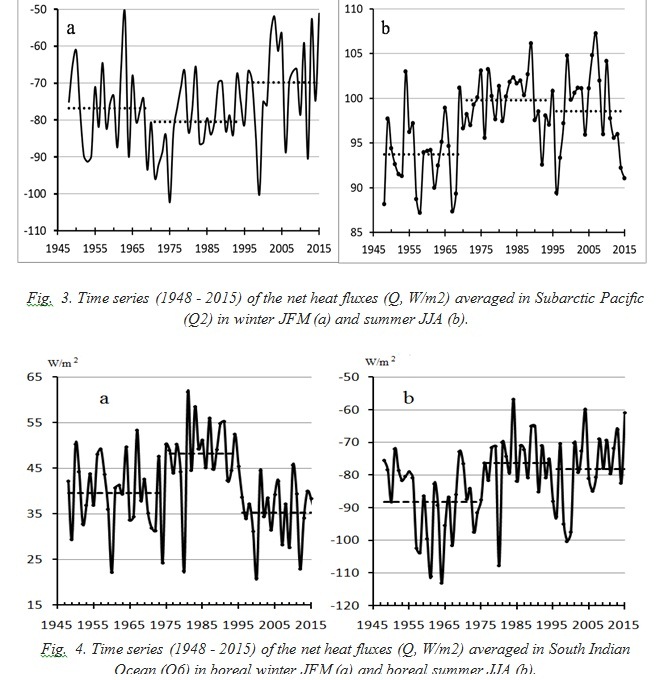
Recent climate shift the net heat flux in 90s in both Subarctic Pacific (Q2) and South Indian Ocean (Q1) is most prevailed in boreal winter (Fig. 1a, Fig. 2a). Rapid reduction of Q directed to the ocean in South Indian (summer in Southern Hemisphere) accompany rapid reduction of Q directed from the ocean to the atmosphere in the Subarctic Pacific (Northern Hemisphere).
Two shifts of the climate regime both in mid 70s and late 90s are also revealed in terms of phase trajectory of PC1, PC2 of set included 18 time series of differences between values of both Q and SLP in boreal winter in all of 6 selected areas (Fig. 1).
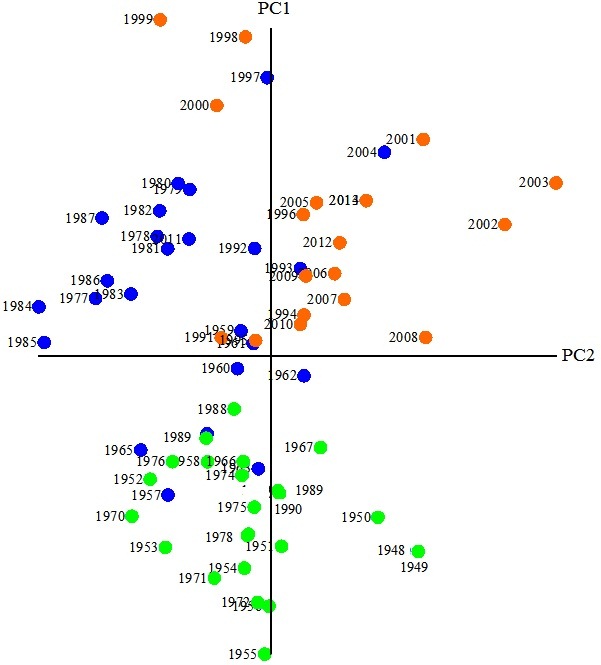
Fig. 5. Phase trajectory of 3-years running mean PC1 and PC2 of set, which includes 18 time series (1948 - 2015) of differences between the values of both Q and SLP in boreal winter averaged within all of 6 selected areas (Fig. 1). Three classes of the time series determined by cluster analyses are marked by color symbols.
Two climate regime shifts are also found in terms of phase trajectory of 3-years running mean annual SAT differences, particularly between regions T2-T4, T1-T2 (Fig.6), as well as in phase trajectory of PC1 and PC2 of set (Fig. 7), which includes 12 time series (1948 - 2015) of annual Q and TWC in all of 6 selected areas. Thus, the climate regime is significantly changed in the Asian Pacific region, Indian and Southern Ocean at the end of the 20th century in terms of Q, SLP, SST, SAT, TWC, Precipitation, and their horizontal gradients on the planetary scale. Recent climate regime in comparison with previous one is characterized by reduce of Q amplitude in annual cycle and meridional gradients of annual and seasonal Q. Absolute values of Q directed to the ocean in summer and to the atmosphere in winter are usually reduced after late 90s of the 20th century. It accompanies change in the ocean vertical structure, circulation and meridional heat transport.
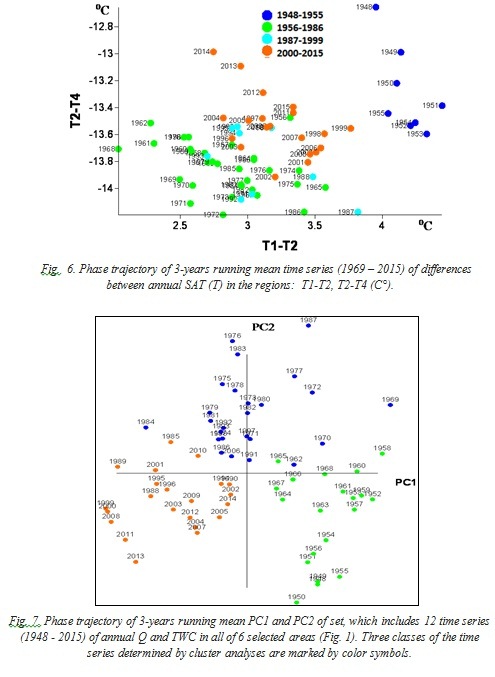
Map of difference between mean SLP in recent climate regime in 1996 – 2015 and previous one 1975 - 1993 for winter and summer (Fig.8) show detailed structure of the climate change in SLP fields at the end of the 20th century.

Fig. 8. Differences of SLP between its mean values within the recent climate regime 1996 – 2014 and previous one 1971-1991 in boreal winter (a) and boreal summer (b).
After the recent climate regime in late 90s the SLP increases mainly in central extratropics of both North and South Pacific, in South Indian Ocean, being maximal changed in winter. The SLP also increases in central continental Asia of temperate latitudes, particularly in Mongolia and South Siberia, Baikal Lake Basin, where maximal large scale SLP change in typical for summer. The SLP decrease and intensification of cyclonic activity occur in the marginal areas of the North and South Pacific, Indian, Southern and Arctic oceans including their marginal seas. Total water content in the atmosphere and precipitation significantly increase in this zone. Surface air temperature in most of marginal areas rises in fall and winter while decrease in spring and early summer. Repeatability of number of strong storms has increased in the Western Pacific and its marginal Seas, Western and Eastern Atlantic Ocean.
IV. SUMMER ANOMALIES IN THE RUSSIAN FAR-EAST AND SOUTH SIBERIA
The anomalies in the ocean accompany the SPL increase in Mongolia and Baikal Lake region all the year round. In summer the SLP increases in Europe and most of the East Asia with maximal anomaly in Mongolia and Lake Baikal water basin. It corresponds to summer warming and decrease of precipitation in this area in recent climate regime. High negative anomaly of precipitation in most of South Siberia and Mongolia regions, low Selenga River and other rivers discharge accompany extremely low level of the Lake Baikal in summer 2015. The extremely low total water inflow to the Baikal Lake can be also effected by anthropogenic forcing related to the increased human activity in Selenga River and Baikal Basins. Map of anomalies in summer mean 2015 precipitation (mm/mon) in Irkutsk region of Russia, catchment areas of Lake Baikal and Irkutsk and Bratsk water reservoirs of hydroelectric power stations, as well as time series of precipitation sum (mm/mon) in hydrological spring (AMJ) and summer are shown in Fig. 9 and 10.
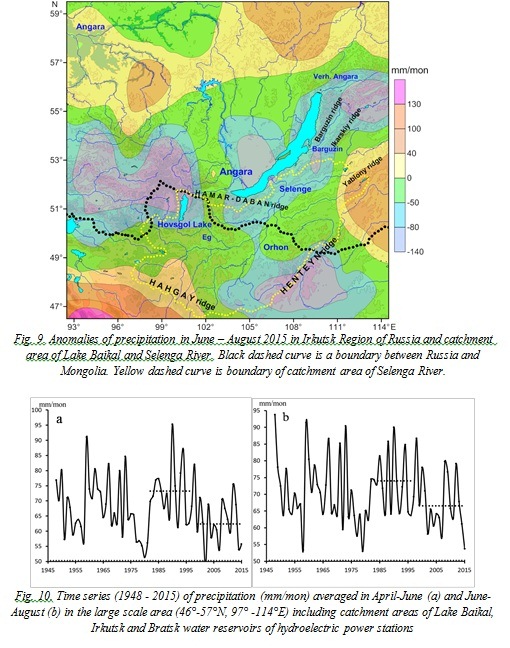
The negative anomaly of precipitation from June to August 2015 is prevailing in the whole area presented in Fig. 9 and in catchment areas of Lake Baikal and Selenga River. The positive anomaly occurs only over surrounding regions, particularly over Hahgay and Yablony Ridges, as well as in northern region adjacent to Bratsk water reservoirs. The recent climate regime is also associated with high SLP and low precipitation in this area (Fig. 10) that is in agreement with [17]. The sharp drop of precipitation began from 1997 and reached low level in 2002, 2007, 2014 and 2015. The effect of accumulated anomalies of precipitation has an important impact on the Lake Baikal level drop in 2015. At the same time, high anomaly of precipitation occurs in South of Primorskii Region of Russia in 2015-2016. In late August 2015 to summer 2016 considerable flood of the Lake Khanka after passing of the typhoon "GONI" in the south of Primorskii Krai was observed on August 26, 2015. Increase of level of the lake and flooding of adjacent lands continues till summer 2016 (recent time) that isn't related to passing of strong typhoons any more. It is basically due to both extreme rise of rainfall in fall 2015, snow in winter 2016 in the Lake Khanka Basin especially over the Pogranichny Ridge (Fig.11, 12, 13) and positive decadal anomaly of mean precipitation from Jan. to Aug. in this area during previous long-term period 2004 to 2015 (Fig. 13).
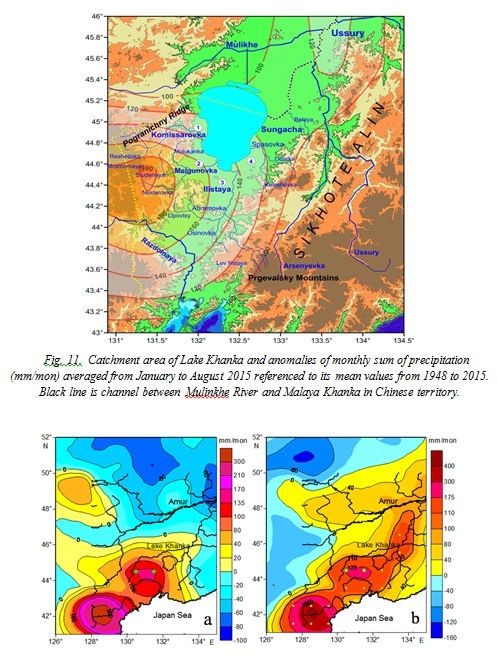
Fig. 12. Anomaly of monthly precipitation sum (mm/mon) in August (a) 2015 and averaged from January to August (b) 2015 in the catchment areas of the Lake Khanka, Amur, Mulinkhe, Ussury Rivers.
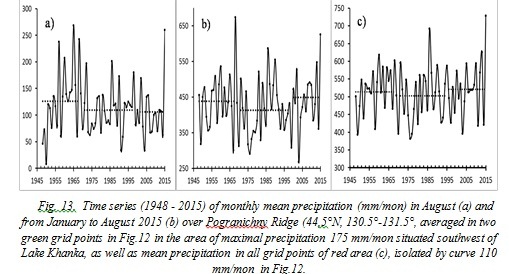
Change of the climatic regime in the ocean – land - atmosphere system results in changes of temperature, salinity structure and circulation in the marginal seas, particularly in the Japan (East) Sea. It is a deep marginal sea with shallow straits and deep and bottom water is formed in the sea. Tataskii Strait is a deep trench between Sakhalin Island and continental slope. In the northern shelf the Tatarskii Strait is connected with the Okhotsk Sea through the shallow and narrow Nevelskoi Strait. Amur River estuary is situated closed to the Nevelskoi Strait and under northern winds fresh water from the Amurskii Liman is transported to Tatarskii Strait along the continental and sometimes along Sakhalin Island bottom slope. Seasonal ice cover is formed in the northern area of the Tatarskii Strait every year. Due to winter cooling, sea ice formation, brain rejection and convection cold water is formed in the Tatarslii Strait every year. In spring and summer typical vertical subarctic water structure with subsurface local temperature minimum was usually observed.
The CTD observations from 1999 to 2015 in the same area of the Tatarskii Strait are presented in Table 2 and Fig.14.
Table 2. CTD Stations in the Tatarskii Strait from 1999 to 2015.
|
N |
Cruise, R/V |
Data |
Lat |
Lon |
№ |
|
125 |
Khromov 36 |
28.07.1999 |
48 |
141.04 |
1 |
|
28 |
Lavrentiev 59 |
19.08.2012 |
48.24 |
141.388 |
2 |
|
18 |
Lavrentiev 62 |
27.06.2013 |
48.13 |
141.22 |
3 |
|
6 |
Lavrentiev 67 |
23.07.2014 |
48.134 |
141.173 |
4 |
|
6 |
Lavrentiev 70 |
19.06.2015 |
48.24 |
141.391 |
5 |
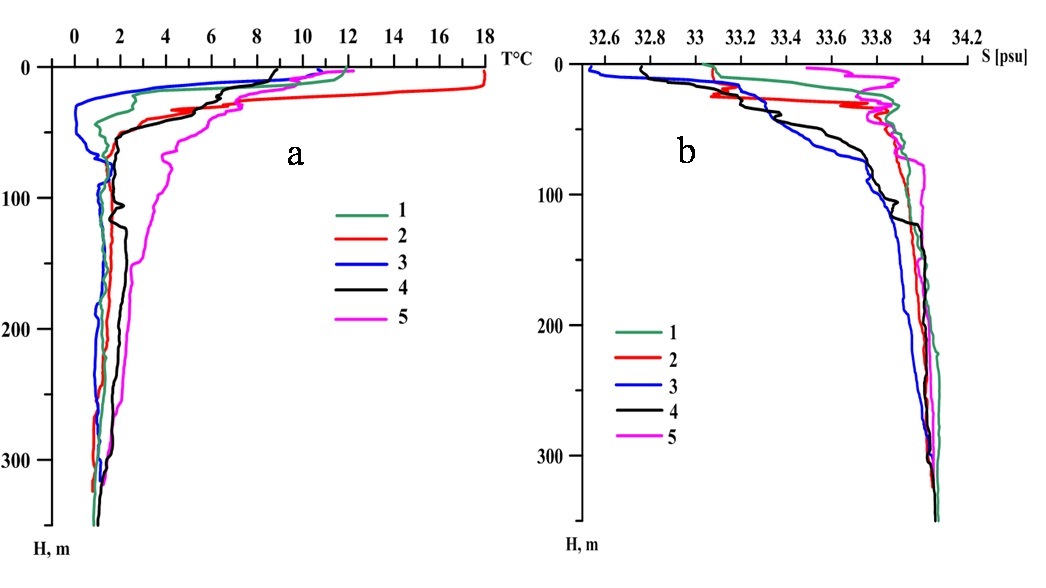
Fig. 14. Temperature (a) and salinity vertical profiles of CTD measurements in the Tatarskii Strait in summer 1999, 2012, 2013, 2014, 2015.
Typical vertical subarctic water structure of temperature and salinity with subsurface local temperature minimum is observed in July 1999, weak in August 2012, maximal in late June 1913, weak in late July 14, while in mid July 2015 the vertical structure became subtropical with significantly increased both temperature and salinity in total water column. This change of the water structure in the Tatarskii Strait in June 2015 is due to increase of subtropical water transport to the northern area of the Japan Sea in this year. This event is associated with warm SST anomaly in the Northeast Pacific in 2014 and in the large scale area of the extratropic Pacific in 2015.
V. Conclusion
Based on the analysis of time series data of meteorological and oceanographic observations, it is shown that the climatic regime is significantly changed at the turn of the 20th and 21st centuries in Asia and the Pacific, Indian, Southern and Arctic oceans. One of major characteristic features of the recent climate regime 1996/1999 – 2016 is associated with the decrease of atmospheric pressure at sea level (SLP) and rise of cyclonic activity in the World Ocean marginal band including most of the Pacific, Atlantic Arctic, Southern Oceans - land large scale transboundary zone including all of marginal seas.
During recent climate regime the precipitable water content in the atmosphere and precipitation significantly increase in this zone that prevailing in a warm period of a year. Surface air temperature rises in most of marginal areas rise in fall winter while decrease in spring and early summer. Repeatability of number of strong storms has increased in the Western Pacific and its marginal Seas, Western and Eastern Atlantic Ocean. It is a main cause of floods in river and lake basins including Amur River Basin in 2013, Rivers in the Primorskii Region of Russian Far East in 2012, 2015 and in the Lake Khanka Basin in 2015-2016.
Second major feature of the recent climate regime is the cyclonic activity reduce and SLP rise prevailing in winter in central extra-tropical Pacific and in South Indian Ocean. Similar SLP rise prevailing in summer is typical for the central continental regions of temperate latitudes, including Mongolia, South Siberia, and Lake Baikal Basin. It is accompanied by significant warming, wildfires, reduction of precipitation, river discharge and fast falling of level of the Lake Baikal. Nevertheless,
VI. Acknowledgment
The part of the work on the interannual, decadal and interdecadal variability of the ice extent in the Okhotsk Sea and Tatarskii Strait of the Japan Sea, wind and net heat flux at the sea surface, which are external parameters and forcing in the eddy-resolved hydrodynamic circulation model, was supported by the Russian Science Foundation (project no.~16--17--10025). The another part of the work on the multiple scale regional climate variability in the northwestern area of the Japan Sea and its linkages was supported by the Program “Dalniy Vostok” of the Russian Branch of the Russian Academy of Sciences (Project 15-I-1-047o), and RFBR Grant 15-05-03805.
1. M.E. Schlesinger and N. Ramankutty, “An oscillation in the global climate system of period 65-70 years,” Nature, vol. 367, February 1994, pp. 723-726.
2. S. Minobe, “A 50-70 year climatic oscillation over the North Pacific and North America,” Geophys. Res. Lett., vol. 24, pp. 683-686, 1997.
3. S. Minobe, “Spatio-temporal structure of the pentadecadal variability over the North Pacific,” Prog. Oceanogr., vol. 47(2-4), pp. 381-408, 2000.
4. S.I. An, “A mechanism for the multi-decadal climate oscillation in the North Pacific,” Theor. Appl. Climatol., vol. 91(1-4), 2008, pp.77-84.
5. Z.M. Gudkovich, V.P. Karklin, and I.E. Frolov. 2005. “Intra-secular changes in climate and sea ice area in the Eurasian Arctic Seas and their possible causes.” Russian Meteorology and Hydrology, N 6, pp. 5-14, 2005; Original Russian Text published in Meteorologiya i gidrologiya, N 6, pp. 5-14, 2005.
6. I.E. Frolov, Z.M. Gudkovich, V.P. Karklin, E.G. Kovalev, and V.M. Smolyanitsky, Climate Change in Eurasian Arctic Shelf Seas: Centennial Ice Cover Observations, Springer Praxis Books Geophys. Sciences, Chichester, UK, p. 164, 2009.
7. I.E. Frolov, Z.M.Gudkovich, V.P.Karklin, and V.M.Smolyanitsky. “Regional peculiarities of the sea ice cover changes in the 20th - early 21st centuries and their causes,” Ice and Snow. N.3, 91-98. 2011.
8. P. Chylek, Ch.K. Folland, G. Lesins, M.K. Dubey, and M. Wang, “Arctic air temperature change amplification and the Atlantic Multidecadal Oscillation,” Geoph. Res. Lett., vol. 36, L14801, July 2009.
9. A.B. Polonsky, “Atlantic multidecadal oscillation and its manifestations in the Atlantic-European region,” Marine Hydrophysical Journal, N 4, pp. 47-58, 2008 (in Russian with English abstract).
10. L. Wu, D. Lee, and Zh. Liu, “The 1976/77 North Pacific Climate Regime Shift: The Role of Subtropical Ocean Adjustment and Coupled Ocean-Atmosphere Feedbacks,” J. Climate., vol.1, pp. 5125-5240, 2005.
11. N. Bond, J. Overland, M. Spillane, and P. Stabeno, “Recent shifts in the state of the North Pacific,” Geophys. Res. Lett., vol. 30(23), pp. 2183-2186, 2003.
12. V.I. Byshev, V.G. Neiman, Yu.A. Romanov, and I. Serykh, “Phase variability of some characteristics of the present-day climate in the Northern Atlantic region,” Doklady Earth Sciences, vol. 438, 2011, pp. 887-892. Original Russian Text published in Doklady Akademii Nauk, vol. 438, pp. 92-96, 2011.
13. S.-W.Yeh, Y.-J. Kang, Y. Noh, and A. J. Miller, “The North Pacific climate transitions of the winters of 1976/77 and 1988/89,” J. Climate, 24(4), 1170-1183, 2011.
14. H.-S. Jo, S.-W. Yeh, and C.-H. Kim, “A possible mechanism for the North Pacific regime shift in winter of 1998/1999,” Geophys. Res. Lett., vol. 40, pp.4380-4385, 2013.
15. V.I. Ponomarev, E.V. Dmitrieva, and S.P. Shkorba, “Featuries of climatic regimes in the North Asia Pacific,” Sistemy kontrolya okruzhayuschei sredy, (J. Systems of environment control published in Russian), Sebastopol, vol. 1 (21), pp. 67-72, 2015.
16. S. Shkorba, Е. Dmitrieva, V. Ponomarev, L. Kuimova, V. Pustoshnova, “Winter climatic anomalies in the Japan, Okhotsk Seas, Baikal Lake Basin and their linkages,” in this EMECS’11- SEACOAST’26 Conference proceedings, 2016 (in press).
17. T.V. Berezhnikh, O.Yu. Marchenko, Y.V. Abasov, V.I. Mordvinov, “Change of summer circulation in the atmosphere over East Asia and formation of long-term dry period catchment areas of Lake Baikal,” Geografiya i prirodnye resursy, N3, pp.61-68, 2012 (in Russian).







